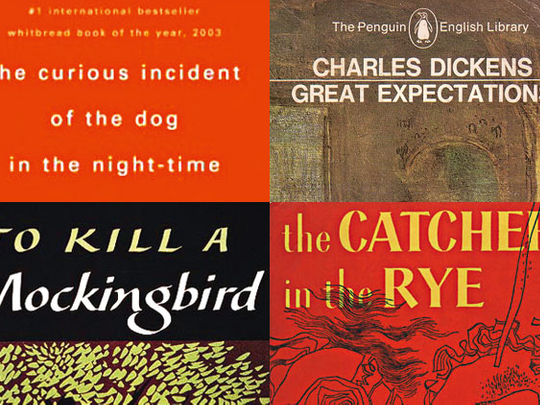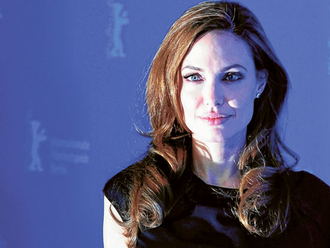
The Fault in Our Stars
John Green, 2012
Soon to be made into a film starring The Descendants’ Shailene Woodley, TFIOS, as fans call it, has been making waves among young adult (YA) readers ever since it shot to the top of the New York Times best-seller list last year. A poignant, bittersweet tale, it’s the story of Hazel Lancaster, a 16-year-old battling stage-four thyroid cancer. When she falls in love with fellow sufferer, Gus, who she meets at a cancer support group, they decide to take a trip to Amsterdam to meet the author of their favourite book and fulfil Gus’ last wish. What could easily be another bucket-list story is steered close to literary perfection through Green’s exquisite blend of humour and tragedy, with critics endorsing it as an adult read too.
The Harry Potter series
JK Rowling, 1997-2011
This seven-book series matures along with its characters, with the darker themes of death and loss really coming to the fore in the fourth book, Harry Potter and the Goblet of Fire. Having reignited the joy of reading for youngsters through its creativity and humour, the franchise cast a spell over people of all ages and it’s even made it on to the curriculum of a UK exam board.
The Curious Incident of the Dog in the Night Time
Mark Haddon, 2003
Haddon’s 15-year-old hero, Christopher John Francis Boone, is a mathematical boy genius. But he also suffers from Asperger’s syndrome, making social interactions painfully difficult. When he is suspected of murdering Wellington, the neighbour’s dog, he decides to independently investigate the dog’s death and prove his innocence, discovering one truth too many in the process. The world as Christopher perceives it – replete with his frustrations, joys and fears – brings alive the chaotic thrust from childhood to adulthood that adolescents face.
The Perks of Being a Wallflower
Stephen Chbosky, 1999
Yes, the 2012 movie hit starring Emma Watson – which was nominated for Writer’s Guild and MTV awards, among others – is based on a literary original that fed end-of-the-millennium teens the concept of being ‘infinite’. On the brink of entering high school without his best friend, who died a few months before, Charlie resorts to writing letters to a stranger in a bid to handle his anxiety and loneliness. The letters track his progress from the margins of life to the centre of things as he gradually finds a sense of belonging. Laced with nostalgic 1990s pop culture, it is as pertinent a Bildungsroman (coming of age story) now as it was then.
The Princess Bride
William Goldman, 1973
Goldman didn’t specifically write his 1973 masterpiece for adolescents – the cult adult following of the 1987 film adaptation proved that. But there’s an intrinsically offbeat,
fairy tale charm to his epic fantasy, ensuring it’s a YA favourite. Buttercup, ‘the world’s most beautiful woman’ and Westley, her farmhand, have boarded the love train bound to happily ever after. But when Westley is presumed dead, she’s abducted
by the dastardly trio of Fezzik the Giant, Inigo Montoya the Fencer and The Sicilian. A complex plot teeming with larger-than-life characters and cryptic life lessons, it’s a page-turner fuelled by love, action and wry satirical humour.
The Outsiders
SE Hinton, 1967
Considered to be the novel that set the ball rolling for YA fiction, Hinton wrote the majority of her controversial 1967 debut as a 16-year-old highschooler herself. Set in Oklahoma, Hinton’s story traces the lives of rival groups of teenagers: The Greasers, from the wrong side of the tracks, and the Socials (Socs), rich jet-setters. Told through 14-year-old Ponyboy Curtis, this gritty novel deals with the archetypal YA themes of socioeconomic struggle, ethical conflict and the pursuit of happiness. Francis Ford Coppola’s onscreen adaptation was one of the defining films of the 1980s, and the book is still a set text for many schools today.
To Kill a Mockingbird
Harper Lee, 1960
This Pulitzer Prize-winning classic has a lot more in common with the young-adult genre than you might think. The novel is six-year-old Scout Finch’s honest observations of growing up in the conservative American South with her older brother and best friend, while her father defends Tom Robinson, a black man accused of assaulting a white woman. Lee’s simple language and humorous tone effectively convey serious themes of prejudice, discrimination and hypocrisy, while showing how the incidents around her transform Scout. The end of the novel marks Scout’s loss of innocence, but not her faith in human goodness – something adults and youngsters need in great measure today.
The Lord of The Rings
JRR Tolkien, 1954
Every novel belonging to the fantasy fiction genre is eventually boiled down to the singular question – is it as good as The Lord of The Rings? But the hobbit Frodo Baggins’ journey through Middle Earth to destroy the ring that is the source of Dark Lord Sauron’s evil is as much a coming-of-age tale as any other YA book. Tolkien’s magnum opus has also been the inspiration for other important works in the YA fantasy genre such as Christopher Paolini’s Inheritance Cycle and CS Lewis’ The Chronicles of Narnia.
The Catcher in the Rye
JD Salinger, 1951
Through his iconic anti-hero, Holden Caulfield, Salinger captured the quintessential adolescent conflict in colloquial teenage lingo – aspiring to the adult world and its ways, yet disheartened by the materialism it embodies. From an undisclosed sanatorium Holden Caulfield narrates in first person the incidents from defining days of his life after being expelled from school. In a plot made up of sleepy everyday activity, the psychological analysis of his surroundings makes for an eye-opening read. Add to that evocative descriptions of 1950s New York and what it was like to be young and alienated in the city of dreams and it’s obvious why the book has such a cult following, even 62 years after its publication.
Great Expectations
Charles Dickens, 1861
One of the most famous Bildungsroman novels of all time, Pip, the first-person narrator, is said to be the character who most resembles Dickens himself. We follow Pip’s 30-year transformation from a poor seven-year-old orphan in the Kent marshes to a young gentleman with great expectations, in the form of money bestowed upon him by an anonymous donor. He assumes his benefactor to be the eccentric Miss Haversham – whose icily beautiful ward, Estella, he is madly in love with – but events reveal another far more sinister plotline. Part morality play, part social critique and part romance, this nuanced novel has only profited from its many screen adaptations.








